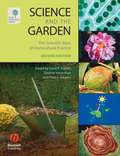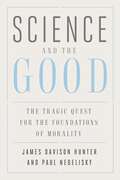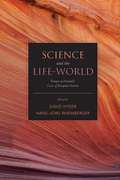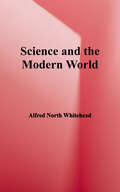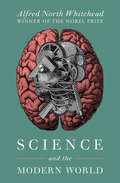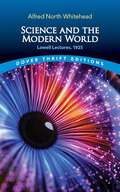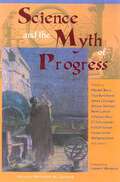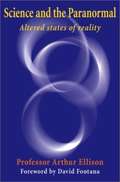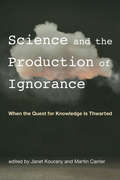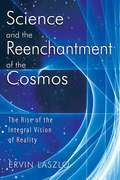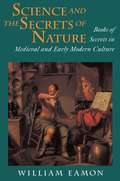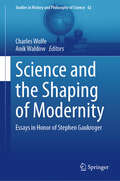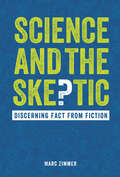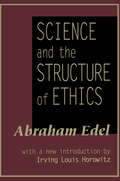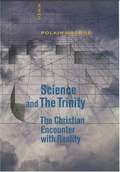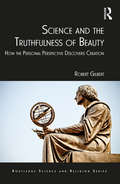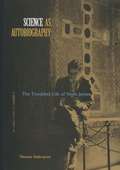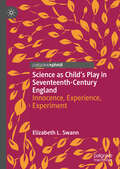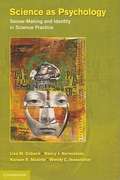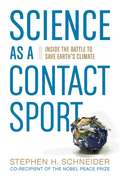- Table View
- List View
Science and the Enlightenment
by Thomas L. HankinsScience and the Enlightenment is a general history of eighteenth-century science covering both the physical and life sciences. It places the scientific developments of the century in the cultural context of the Enlightenment and reveals the extent to which scientific ideas permeated the thought of the age. The book takes advantage of topical scholarship, which is rapidly changing our understanding of science during the eighteenth century. In particular it describes how science was organized into fields that were quite different from those we know today. Professor Hankins's work is a much needed addition to the literature on eighteenth-century science. His study is not technical; it will be of interest to all students of the Enlightenment and the history of science, as well as to the general reader with some background in science.
Science and the Garden
by Peter J. Gregory Daphne Vince-Prue David S. Ingram"A thorough update and the introduction of new topics such as biodiversity and conservation has greatly enhanced this new edition: it is a 'must read' for all interested in horticulture and gardening."--John MacLeod, RHS Professor of HorticultureMost conventional gardening books concentrate on how and when to carry out horticultural tasks such as pruning, seed sowing and taking cuttings. This book is unique in explaining in straightforward terms some of the science that underlies these practices. It is principally a book of 'Why' - Why are plants green? Why should one cut beneath a leaf node when taking cuttings? Why do plants need so much water? But it also goes on to deal with the 'How', providing rationale behind the practical advice.The coverage is wide-ranging and comprehensive and includes the basic structure and functioning of garden plants, nomenclature, genetics and plant breeding, soil management, environmental factors affecting growth, methods of propagation and production, pest and disease control, post harvest management and storage, and conservation and sustainable horticulture.Now with full colour throughout, the second edition provides the reader with:Completely revised and updated chapters from the first edition, with new information and clearer focus on the topicsFour new chapters, dealing with matters that have become of increasing concern since the first edition, namely: Diversity in the Plant World; Conservation and Sustainable Gardening; Gardens and the Natural World; and Gardens for SciencePublished on behalf of the Royal Horticultural Society, this book remains a key text for those sitting RHS examinations, particularly at levels 2 and 3; it will also appeal to gardeners, growers and scientists.Key FeaturesBestselling essential text for all horticulture studentsEdited and written by a group of highly regarded scientistsCovers the scientific information of greatest importance to gardeners and horticulturistsJargon-free scientific explanations, a comprehensive glossary, and copious colour illustrationsRoyalties from the sale of this book go towards the charitable work of the RHS, promoting horticulture and helping gardeners. www.rhs.org.uk
Science and the Garden: The Scientific Basis of Horticultural Practice
by Peter J. Gregory Daphne Vince-Prue David S. Ingram"A thorough update and the introduction of new topics such as biodiversity and conservation has greatly enhanced this new edition: it is a 'must read' for all interested in horticulture and gardening." —John MacLeod, RHS Professor of Horticulture Most conventional gardening books concentrate on how and when to carry out horticultural tasks such as pruning, seed sowing and taking cuttings. This book is unique in explaining in straightforward terms some of the science that underlies these practices. It is principally a book of 'Why' – Why are plants green? Why should one cut beneath a leaf node when taking cuttings? Why do plants need so much water? But it also goes on to deal with the 'How', providing rationale behind the practical advice. The coverage is wide-ranging and comprehensive and includes the basic structure and functioning of garden plants, nomenclature, genetics and plant breeding, soil management, environmental factors affecting growth, methods of propagation and production, pest and disease control, post harvest management and storage, and conservation and sustainable horticulture. Now with full colour throughout, the second edition provides the reader with: Completely revised and updated chapters from the first edition, with new information and clearer focus on the topics Four new chapters, dealing with matters that have become of increasing concern since the first edition, namely: Diversity in the Plant World; Conservation and Sustainable Gardening; Gardens and the Natural World; and Gardens for Science Published on behalf of the Royal Horticultural Society, this book remains a key text for those sitting RHS examinations, particularly at levels 2 and 3; it will also appeal to gardeners, growers and scientists. Key Features Bestselling essential text for all horticulture students Edited and written by a group of highly regarded scientists Covers the scientific information of greatest importance to gardeners and horticulturists Jargon-free scientific explanations, a comprehensive glossary, and copious colour illustrations Royalties from the sale of this book go towards the charitable work of the RHS, promoting horticulture and helping gardeners. www.rhs.org.uk
Science and the Good: The Tragic Quest for the Foundations of Morality (Foundational Questions in Science)
by James Davison Hunter Paul NedeliskyWhy efforts to create a scientific basis of morality are neither scientific nor moral: &“Important and timely.&”—The Wall Street Journal In this illuminating book, James Davison Hunter and Paul Nedelisky trace the origins and development of the centuries-long, passionate, but ultimately failed quest to discover a scientific foundation for morality. The &“new moral science&” led by such figures as E.O. Wilson, Patricia Churchland, Sam Harris, Jonathan Haidt, and Joshua Greene is only the newest manifestation of that quest. Though claims for its accomplishments are often wildly exaggerated, this new iteration has been no more successful than its predecessors. But rather than giving up in the face of this failure, the new moral science has taken a surprising turn. Whereas earlier efforts sought to demonstrate what is right and wrong, the new moral scientists have concluded, ironically, that right and wrong don&’t actually exist. Their (perhaps unwitting) moral nihilism turns the science of morality into a social engineering project. If there is nothing moral for science to discover, the science of morality becomes, at best, a feeble program to achieve arbitrary societal goals. Concise and rigorously argued, Science and the Good is a definitive critique of a would-be science that has gained extraordinary influence in public discourse today—and an exposé of that project&’s darker turn. &“Science and the Good is a closely argued, always accessible riposte to those who think scientific study can explain, improve or even supersede morality . . . A generous and thoughtful critique.&” —The Daily Telegraph
Science and the Life-World
by David Hyder Hans-Jörg RheinbergerThis book is a collection of essays on Husserl'sCrisis of European Sciencesby leading philosophers of science and scholars of Husserl. Published and ignored under the Nazi dictatorship, Husserl's last work has never received the attention its author's prominence demands. In theCrisis, Husserl considers the gap that has grown between the "life-world" of everyday human experience and the world of mathematical science. He argues that the two have become disconnected because we misunderstand our own scientific past-we confuse mathematical idealities with concrete reality and thereby undermine the validity of our immediate experience. The philosopher's foundational work in the theory of intentionality is relevant to contemporary discussions ofqualia, naive science, and the fact-value distinction. The scholars included in this volume consider Husserl's diagnosis of this "crisis" and his proposed solution. Topics addressed include Husserl's late philosophy, the relation between scientific and everyday objects and "worlds," the history of Greek and Galilean science, the philosophy of history, and Husserl's influence on Foucault.
Science and the Modern World
by Alfred North WhiteheadThe history of science, including mathematics, relativity, quantum mechanics, science and philosophy, science and religion.
Science and the Modern World
by Alfred North WhiteheadThis book originally published in 1925, redefines the concept of modern science. Taking readers through the history of modern science, Whitehead shows how cultural history has affected science over the ages in relation to such major intellectual themes as romanticism, relativity, quantum theory, religion, and movements for social progress.
Science and the Modern World: Lowell Lectures, 1925
by Alfred North WhiteheadThe famed mathematician and philosopher takes readers on a journey into a new scientific age, exploring topics from relativity to religion. Alfred North Whitehead, one of the great figures in the philosophy of science, wrote this prescient work nearly a century ago. Yet, in an era that has us reckoning with science and technology&’s place and meaning in our lives, it remains as relevant as ever. Science and the Modern World puts scientific discovery into historical and cultural context—exploring the effects of science and people on each other. &“It is a work not only of the first importance but also of great beauty. . . . Vivid writing.&” —Nature
Science and the Modern World: Lowell Lectures, 1925 (Dover Thrift Editions: Philosophy)
by Alfred North WhiteheadIn 1925, philosopher Alfred North Whitehead presented a series of eight lectures, delivering a groundbreaking exploration of the cultural and philosophical implications of scientific progress from the classical civilizations of the ancient world to the nineteenth century. One of the most influential thinkers of the twentieth century, Whitehead posits philosophy as a critical interpreter, illuminating science's hidden assumptions and bridging the gap between scientific findings and the evolving human experience. The lectures examined how scientific discoveries reshaped our perception of the physical world and redefined how we understand our place in the universe. Whitehead's insightful commentary remains a significant contribution to the ongoing dialogue between science and the humanities and prompts a holistic worldview, reflecting the interconnectedness of all aspects of existence. It is an essential read for those interested in the "process philosophy" of science.
Science and the Myth of Progress
by Mehrdad M. ZarandiA collection of essays by scholars, philosophers, and scientists offering penetrating answers to some of the most important questions of the day.
Science and the Paranormal: Altered States of Reality
by Arthur J. EllisonReviews the empirical evidence for the existence of paranormal abilities, describes the author's experiences in this field, and gives practical advice for readers wishing to develop these abilities.
Science and the Production of Ignorance: When the Quest for Knowledge Is Thwarted (The\mit Press Ser.)
by Martin Carrier Janet KouranyAn introduction to the new area of ignorance studies that examines how science produces ignorance—both actively and passively, intentionally and unintentionally.We may think of science as our foremost producer of knowledge, but for the past decade, science has also been studied as an important source of ignorance. The historian of science Robert Proctor has coined the term agnotology to refer to the study of ignorance, and much of the ignorance studied in this new area is produced by science. Whether an active or passive construct, intended or unintended, this ignorance is, in Proctor's words, “made, maintained, and manipulated” by science. This volume examines forms of scientific ignorance and their consequences.A dialogue between Proctor and Peter Galison offers historical context, presenting the concerns and motivations of pioneers in the field. Essays by leading historians and philosophers of science examine the active construction of ignorance by biased design and interpretation of experiments and empirical studies, as seen in the “false advertising” by climate change deniers; the “virtuous” construction of ignorance—for example, by curtailing research on race- and gender-related cognitive differences; and ignorance as the unintended by-product of choices made in the research process, when rules, incentives, and methods encourage an emphasis on the beneficial and commercial effects of industrial chemicals, and when certain concepts and even certain groups' interests are inaccessible in a given conceptual framework.ContributorsMartin Carrier, Carl F. Cranor, Peter Galison, Paul Hoyningen-Huene, Philip Kitcher, Janet Kourany, Hugh Lacey, Robert Proctor, Londa Schiebinger, Miriam Solomon, Torsten Wilholt
Science and the Reenchantment of the Cosmos: The Rise of the Integral Vision of Reality
by Ervin LaszloPresents a revolutionary new theory that bridges the divide between science and spirituality• Discloses the ramifications of non-localized consciousness and how the physical world and spiritual experience are two aspects of the same reality• Includes contributions from Jane Goodall, Ed Mitchell, Stanislav Grof, Ralph Abraham, and Christian de Quincy, among othersWhat scientists are now finding at the outermost frontiers of every field is overturning all the basic premises concerning the nature of matter and reality. The universe is not a world of separate things and events but is a cosmos that is connected, coherent, and bears a profound resemblance to the visions held in the earliest spiritual traditions in which the physical world and spiritual experience were both aspects of the same reality and man and the universe were one. The findings that justify this new vision of the underlying logic of the universe come from almost all of the empirical sciences: physics, cosmology, the life sciences, and consciousness research. They explain how interactions lead to interconnections that produce instantaneous and multifaceted coherence--what happens to one part also happens to the other parts, and hence to the system as a whole. The sense of sacred oneness experienced by our ancestors that was displaced by the unyielding material presumptions of modern science can be restored, and humanity can once again feel at home in the universe.
Science and the Secrets of Nature: Books of Secrets in Medieval and Early Modern Culture
by William EamonBy explaining how to sire multicolored horses, produce nuts without shells, and create an egg the size of a human head, Giambattista Della Porta's Natural Magic (1559) conveys a fascination with tricks and illusions that makes it a work difficult for historians of science to take seriously. Yet, according to William Eamon, it is in the "how-to" books written by medieval alchemists, magicians, and artisans that modern science has its roots. These compilations of recipes on everything from parlor tricks through medical remedies to wool-dyeing fascinated medieval intellectuals because they promised access to esoteric "secrets of nature." In closely examining this rich but little-known source of literature, Eamon reveals that printing technology and popular culture had as great, if not stronger, an impact on early modern science as did the traditional academic disciplines.
Science and the Shaping of Modernity: Essays in Honor of Stephen Gaukroger (Studies in History and Philosophy of Science #62)
by Charles Wolfe Anik WaldowThis book collects a variety of short essays on Stephen Gaukroger’s thought, by leading scholars, both senior and junior. Stephen Gaukroger (1950–2023) was one of the preeminent specialists of early modern science and philosophy, particularly their interrelations including under the heading ‘natural philosophy’, on the international scene, since the 1980s, starting with his prominent Cartesian scholarship (and biography) and moving towards the formidable 4-volume series on science and the shaping of modernity (from Emergence of a Scientific Culture to Civilization and the Culture of Science), dealing not just with early modernity but with the Enlightenment, German Romanticism and 20th-century society. This volume covers the thought of this highly-recognized scholar and engages with his works covering early modern philosophy, enlightenment, and contemporary periods, making it a must-read for any philosopher and historian of science.
Science and the Skeptic: Discerning Fact from Fiction
by Marc ZimmerFake news, pseudoscience, and quackery have become scourges, spreading through society from social media all the way to Congress. The line between entertainment and reality, between fact and fiction, has become blurred. Some of the most crucial issues of our time—climate change, vaccines, and genetically modified organisms—have become prime targets for nefarious disinformation campaigns. Far too many people have become distrustful of real science. Even those who still trust science no longer know what to believe or how to identify the truth. Not only does this result in the devaluation and distrust of real science, but it is also dangerous: people acting based on false information can hurt themselves or those around them. We must equip ourselves with the knowledge and skills to fight back against all this disinformation. InScience and the Skeptic: Discerning Fact from Fiction, you will learn how science is done, from the basic scientific method to the vetting process that scientific papers must go through to become published; how and why some people intentionally or unintentionally spread misinformation; and the dangers in believing and spreading false information. You'll also find twenty easy-to-follow rules for distinguishing fake science from the real deal. Armed with this book, empower yourself with knowledge, learning what information to trust and what to dismiss as deceit. "We're not just fighting an epidemic; we're fighting an infodemic. . . . This is a time for facts, not fear. This is a time for rationality, not rumors. This is a time for solidarity, not stigma."—Tedros Adhanom Ghebreyesus, director-general of the WHO "Our deepest beliefs should help navigate reality, not determine it."—Michael Gersen, The Washington Post "Journalism is very much about trying to simplify and distribute information about what's new and where advances have been made. That's incompatible with the scientific process, which can take a long time to build a body of evidence."—Kelly McBride, Poynter Institute
Science and the Structure of Ethics
by Abraham EdelInitially prepared as part of the Foundations of the Unity of Science volumes under the auspices of the International Encyclopedia of Unified Science, Science and the Structure of Ethics soon took on a life of its own. Well positioned in the naturalistic tradition of ethical theory extending from John Dewey at the start and Richard Rorty at the conclusion of the century, Abraham Edel's volume offers a remarkable synthesis of the ways hi which ethical statements can be examined, and the nature of ethical concerns.Edel reveals a singular capacity to move beyond oracular controversies of the good and the right hi favor of a comparative, analytic, and functional account of how ethical perspectives and practices affect the content of moral discourse. In Edel's work, the structure of ethical behavior is defined by biological, psychological, social, and historical functions. Hence a scientific account of ethics is possible since moral norms are themselves products of an experiential field open to verification procedures common to all other walks of human life.In reviewing the impact of Edel's work hi general, and this volume in particular, Irving Louis Horowitz notes that Edel's naturalistic emphasis fits neatly with a view of ethics as something grounded in human experience rather than mandated from divine assumption: "It is hard for me to imagine a turning back from the hard lessons of the century, any more in ethical theory than in empirical research as such. We owe a central place in our century's intellectual capital to Edel's examination of ethical doctrines in the light of changing circumstances." This is a work certain to enlist the interest of ethicists, sociologists of knowledge, as well as those concerned with issues hi the philosophy of science and religion alike.
Science and the Trinity: The Christian Encounter with Reality
by John C. PolkinghorneMost often, the dialogue between religion and science is initiated by the discoveries of modern science--big bang cosmology, evolution, or quantum theory, for example. In this book, scientist-theologian John Polkinghorne changes the discussion. He approaches the dialogue from a little-explored perspective in which theology shapes the argument and sets the agenda of questions to be considered. The author begins with a review of approaches to science and religion in which the classification focuses on theological content rather than on methodological technique. He then proceeds with chapters discussing the role of Scripture, a theology of nature, the doctrine of God, sacramental theology, and eschatology. Throughout, Polkinghorne takes the perspective of Trinitarian thinking while arguing in a style that reflects the influence of his career as a theoretical physicist. In the final chapter, the author defends the appropriateness of addressing issues of science and religion from the specific standpoint of his Christian belief. His book provides an important model for theologians and scientists alike, showing how their two fields can inform one another in significant ways.
Science and the Truthfulness of Beauty: How the Personal Perspective Discovers Creation (Routledge Science and Religion Series)
by Robert GilbertWhen scientists describe their results or insights as 'beautiful', are they using the term differently from when they use it of a landscape, music or another person? Science and the Truthfulness of Beauty re-examines the way in which seeing beauty in the world plays the key role in scientific advances, and argues that the reliance on such a personal point of view is ultimately justified by belief that we are made in the 'image of God', as Christian and Jewish believers assert. It brings a fresh voice to the ongoing debate about faith and science, and suggests that scientists have as much explaining to do as believers when it comes to the ways they reach their conclusions.
Science as Autobiography: The Troubled Life of Niels Jerne
by Thomas Soderqvist Niels Kaj Jerne David Mel PaulThis biography probes the unusual mind, the dramatic life, and the outstanding scientific work of Danish-born immunologist Niels Jerne (1911-1994). Jerne's Nobel Prize-winning achievements in the field of immunology place him in the pantheon of great twentieth-century biomedical theorists, yet his life is perhaps even more interesting than his science. Science as Autobiography tells Jerne's story, weaving together a narrative of his experiences, emotional life, and scientific work, and arguing that the source of Jerne's extraordinary creativity as a scientist rested in his life story. Drawing on Jerne's own extensive archives, on more than 150 hours of conversation with him, and on the recollections of over 90 friends, colleagues, and relatives, Thomas Soderqvist explores the myths and legends about Jerne - his unparalleled powers of concentration and analytical keenness, his preference for conversation in a Paris cafe over work in the laboratory, his problematic personal life, Soderqvist punctuates the book with Jerne's own voice and makes the argument that Jerne's life experience and view of himself became a metaphorical resource for the construction of his theories. The author also probes the moral issues that surrounded Jerne's choice to sacrifice the welfare of his family in favor of scientific goals and the pursuit of excellence. --BOOK JACKET. Title Summary field provided by Blackwell North America, Inc. All Rights Reserved
Science as Child’s Play in Seventeenth-Century England: Innocence, Experience, Experiment
by Elizabeth L. SwannIn recent decades, scholars have uncovered the vital contributions made by non-elite figures, including women, artisans, and indigenous peoples, to the development of early modern natural philosophy. This Palgrave Pivot argues that children, too, quite literally played a decisive role in seventeenth-century experimental science in England, both as rhetorical exemplars, and as active contributors in the generation of natural knowledge. Exploring a widespread but critically-neglected connection between experiment and child’s play, it both illuminates the extent to which children participated – intentionally or incidentally – in natural historical and experimental activities, and investigates how ideas about childish innocence and sensory receptivity informed the nascent ideology of scientific objectivity. In the work of figures associated with the early Royal Society, this book proposes, children emerge as instinctive empiricists and experimenters, setting in motion a broader cultural transformation in ideas about childhood and education which still shapes how we think about these things today.
Science as Psychology
by Lisa M. Osbeck Nancy J. Nersessian Kareen R. Malone Wendy C. NewstetterScience as Psychology reveals the complexity and richness of rationality by demonstrating how social relationships, emotion, culture and identity, are implicated in the problem-solving practices of laboratory scientists. The authors gather and analyze interview and observational data from innovation-focused laboratories in the engineering sciences to show how the complex practices of laboratory research scientists provide rich psychological insights, and how a better understanding of science practice facilitates understanding of human beings more generally. The study focuses not on dismantling the rational core of scientific practice, but on illustrating how social, personal and cognitive processes are intricately woven together in scientific thinking. The authors argue that this characterization addresses the integration problem in science studies - how to characterize the fluid entanglements of cognitive, affective, material, cultural and other dimensions of discovery and problem solving. The book is thus a contribution to science studies, the psychology of science and general psychology.
Science as a Contact Sport: Inside the Battle to Save Earth's Climate
by Stephen H. SchneiderSchneider persuasively outlines a plan to avert the building threat and develop a positive, practical policy that will bring climate change back under our control, help the economy with a new generation of green energy jobs and productivity, and reduce the dependence on unreliable exporters of oil, and thus ensure a future for ourselves and our planet that's as rich with promise as our past.
Science as a Cultural Human Right (Pennsylvania Studies in Human Rights)
by Helle PorsdamThe human right to science, outlined in the 1948 Universal Declaration of Human Rights and repeated in the 1966 International Covenant on Economic, Social, and Cultural Rights, recognizes everyone’s right to “share in scientific advancement and its benefits” and to “enjoy the benefits of scientific progress and its applications.” This right also requires state parties to develop and disseminate science, to respect the freedom of scientific research, and to recognize the benefits of international contacts and co-operation in the scientific field.The right to science has never been more important. Even before the COVID-19 health crisis, it was evident that people around the world increasingly rely on science and technology in almost every sphere of their lives from the development of medicines and the treatment of diseases, to transport, agriculture, and the facilitation of global communication. At the same time, however, the value of science has been under attack, with some raising alarm at the emergence of “post-truth” societies. “Dual use” and unintended, because often unforeseen, consequences of emerging technologies are also perceived to be a serious risk.The important role played by science and technology and the potential for dual use makes it imperative to evaluate scientific research and its products not only on their scientific but also on their human rights merits. In Science as a Cultural Human Right, Helle Porsdam argues robustly for the role of the right to science now and in the future. The book analyzes the legal stature of this right, the potential consequences of not establishing it as fundamental, and its connection to global cultural rights. It offers the basis for defending the free and responsible practice of science and ensuring that its benefits are spread globally.
Science at Sea
by Jeffrey Fuerst Jeanette LeardiNearly three-quarters of our planet is water, but we have studied only a very small part of the world's oceans. How do scientists do research beneath the sea? (Set of 6 with Common Core Editions of Teacher Materials)


